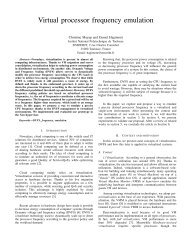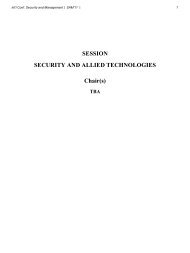SESSION NOVEL ALGORIHMS AND APPLICATIONS + ...
SESSION NOVEL ALGORIHMS AND APPLICATIONS + ...
SESSION NOVEL ALGORIHMS AND APPLICATIONS + ...
Create successful ePaper yourself
Turn your PDF publications into a flip-book with our unique Google optimized e-Paper software.
12 Int'l Conf. Foundations of Computer Science | FCS'11 |<br />
The expected number of steps to find a uniformly chosen<br />
element in the table is the average of the steps needed<br />
to insert them. There are M elements in the table. When<br />
inserting the i-th element, there were i − 1 already inserted.<br />
In other words, the i-the element was inserted into an<br />
α ′ = i−1<br />
N -filled hash-table. The average of these step counts<br />
gives us<br />
E(L α lin) = 1 + 1 α<br />
(5)<br />
2 1 − α<br />
where E(Lα lin ) denotes the expected probe length for linear<br />
probing in an α-filled table.<br />
3.3 Evaluation using probe lengths and wallclock<br />
execution times<br />
Figure 2 shows the expected probe length for linear<br />
probing and uniform hashing for various load factors. It is<br />
obvious that uniform hashing has a smaller expected probe<br />
length. Based on this fact, one could say that linear probing<br />
is to be neglected while choosing hashing algorithms for<br />
practical purposes.<br />
Fig. 2: The expected probe length of linear probing and<br />
uniform hashing for different load factors.<br />
Our experimental results, on the other hand, show different<br />
results. Figure 3 plots the measured wall-clock execution<br />
times of building a table using linear probing and double<br />
hashing. Linear probing has shorter lookup execution than<br />
double hashing. This is the exact opposite of the previous<br />
result.<br />
To resolve this contradiction a new complexity function is<br />
required, one that approximates the true performance of hash<br />
tables. The problem with the probe length based ranking is<br />
that it assumes that every probe has the same cost; instead,<br />
the characteristics of the execution environment have to be<br />
considered and integrated into the cost function.<br />
4. Cache-line aware algorithm complexity<br />
This section presents a simple model of memory hierarchy<br />
which is then incorporated into the cost function of the steps<br />
of the probe sequence.<br />
Fig. 3: The measured wall-clock execution times of linear<br />
probing and uniform hashing for different load factors.<br />
4.1 Caches<br />
Open hash tables span over a large block of allocated<br />
memory. This block is split into slots, which are identified<br />
by a number (memory address; i.e. indexes of the array).<br />
The address of neighboring slots are sequential, therefore in<br />
linear probing, after slot i is visited, whose address is j, the<br />
next slot, i + 1, will have the address j + 1. This is not true<br />
for uniform hashing; the addresses of the probe sequence<br />
will be scattered across the table. Let us explain why this is<br />
important.<br />
In current computer systems CPUs have caches, which<br />
are fast access, but limit space storages integrated into the<br />
CPU or onto the same die. The cache stores a small fraction<br />
of the data that is stored in the system memory, therefore<br />
a small portion of the hash table also resides in the cache.<br />
Whenever the CPU requests data, it is first checked in the<br />
cache. If found, the main system memory is not queried as<br />
the cache returns the data. However, if the data is not in the<br />
cache (this event is called a cache miss), the data is loaded<br />
from the main system memory; this operation is by one or<br />
two orders of magnitude slower than reading from the cache.<br />
An other important factor is cache lines. The memory is<br />
partitioned into small blocks, called cache lines. Whenever<br />
data is loaded into the cache, an entire cache line is loaded;<br />
the one the requested data is inside. This means, that with<br />
a single memory access it is not just the requested data that<br />
is loaded, but some neighboring addresses are read as well<br />
- at no additional cost. If the next read is in this very same<br />
cache line, it will be served by the low latency cache.<br />
If accesses to the memory is temporarily or spatially<br />
local, the cache speeds up the algorithm by not requiring<br />
the system to read data from the system memory. When an<br />
algorithm exploits these effects, it is called cache friendly. It<br />
allows the algorithm to have lots of data requests at fraction<br />
of the cost.<br />
4.2 Cache-line based memory model<br />
The cost difference between accessing data from the<br />
main memory and from the cache is often neglected in









